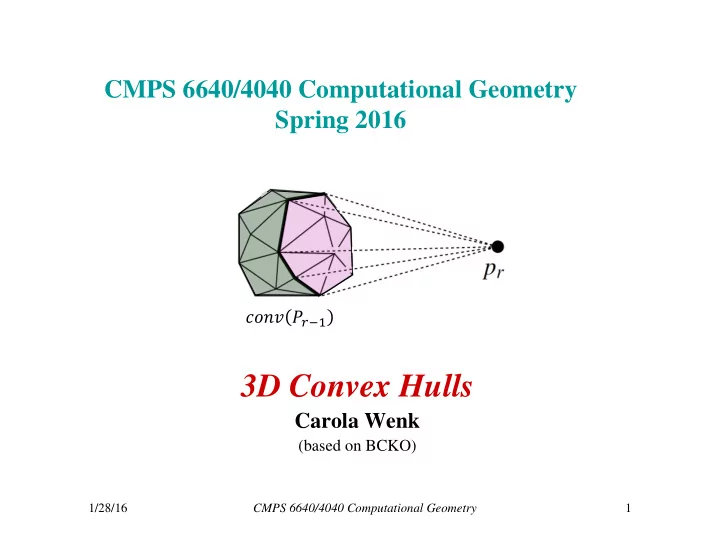

CMPS 6640/4040 Computational Geometry Spring 2016 ���� � ��� 3D Convex Hulls Carola Wenk (based on BCKO) 1/28/16 CMPS 6640/4040 Computational Geometry 1
3D CH: Problem Statement Images from http://xlr8r.info/ � compute • Given a set � � • Use a DCEL to represent the boundary
Clarkson & Shor’s Randomized Incremental Construction (RIC) 1. Choose 4 points in that do not lie in a common plane. (Otherwise apply planar CH algorithm.) Wlog, let these points be � � � � 2. Let � � be a random permutation of the remaining points in . 3. Define � � for � for r ; ; ++ Compute � by inserting � into ���
Visible and Invisible Regions • If � ��� , then � ��� • Now, consider the other case � ��� Look at ��� from � visible region and invisible region ���� � ��� The visible region and invisible region are connected regions on ��� , separated by the horizon . The horizon is a closed curve consisting of edges on ���
Horizon ���� � ��� Project ��� onto a plane with � as the center of projection. Convex polygon that “equals” the horizon.
Visibility ���� � ��� A facet on ��� is visible from � � , where � is the plane containing , : � lies in � � is the open halfspace that does not contain and � ���
Storage Data Structure Store the boundary of , and of all intermediate � , as a DCEL. The vertices are 3D points. Wlog, half-edges bounding a face that is seen from the outside of the polytope form a counter-clockwise cycle.
Compute from ���� � ��� ���� � � • Keep invisible facets • Replace visible facets How to find all visible facets in time linear to their number? � ( time is trivial but leads to an algorithm.)
Conflict/Visibility Lists Maintain conflict lists for each on ��� and � for : � consists of all points that �������� � can see � consists of all facets of �������� ��� visible from � is in conflict with because and �������� cannot be part of the same convex hull ���� � ���
Conflict Graph Store all conflict lists in the conflict graph: • Bipartite graph conflicts • Node for every point in that is not inserted yet • Node for every facet of ��� • Arc between and p if is in conflict with (i.e., visible from)
Maintaining the Conflict Graph • Initialize conflict graph for � in linear time • Update after adding � : – Discard from � : • All neighbors of � � in � . These are the facets visible from � � . • � � – Insert nodes in � for newly created facets (those facets which connect � � to the horizon) – Find conflict lists for each newly created facet � : • A point � � that sees � must also see � • But then � � must have seen one of the faces � � or � � incident to � in conv�P ��� � Test all points in the conflict lists of � � and � �
Algorithm (part 1) ���� � ��� ���� � �
Algorithm (part 2) ���� � ��� ���� � �
Algorithm (part 1) ���� � ��� ���� � � ��� ) ��|� �������� �� � �|� Face can only be deleted if it has been created. Delete at most once
Algorithm (part 2) ���� � ��� ���� � � ��� |� � | � �∈� Charge to node and arc creation Need to bound: � ���� |� �������� �� � �| • ��� |����| ��� log �� where the summation is over all horizon edges � • proof in book that ever appear during the algorithm
Backwards Analysis Lemma: The expected number of facets created by the algorithm, � ��∑ |� �������� �� � �| � , is at most 6� � 20 . ��� Proof: �������� � = # facets connecting � � to its horizon on ���� � ��� (these are the newly created facets) = # facets that disappear when removing � � from ���� � � =: deg �� � , ���� � � � degree of � � in ���� � � � � ��deg � � , ���� � ��� ∑ � deg � � , ���� � � � ��� � Total degree of � � , … , � � is � ��� [( ∑ � deg�� � , ���� � � � ) -12] ��� at least 12 � �������� � ��� [ 2 3� � 6 � 12� � = 6 ��� � Thus 4 � � ∑ |� �������� �� � �| � 4 � 6 � � 4 � 6� � 20 ���
Convex Hull Runtime � • Theorem: The convex hull of a set of points in can be computed in randomized expected time. • Theorem (higher dimensions): The complexity of the ��/�� . � is convex hull of points in It can be computed in randomized expected ��/�� time.
Recommend
More recommend